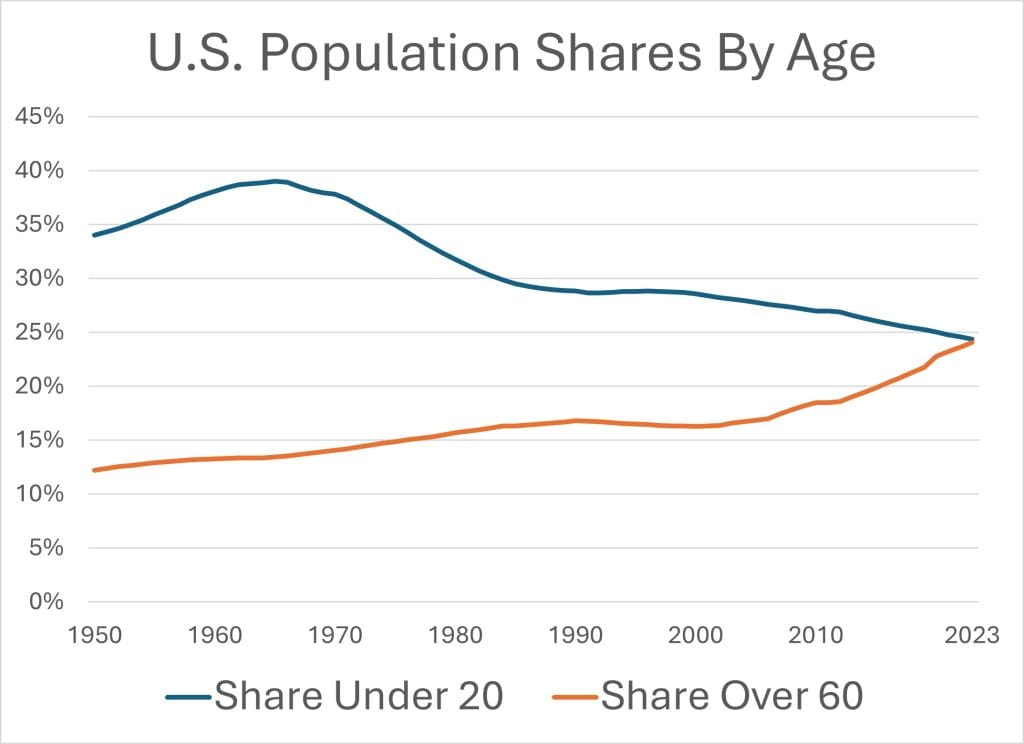By Floyd Norris
The aging of America continues, and it seems likely that this year there will be more people over 60 than people under 20 in this country, the first time that has ever happened.

As recently as 1980, there were twice as many people under 20 – most of whom were yet to enter their working years – as there were over 60 – people who were nearing retirement or were already there.
On July 1, 2023, the Census Bureau estimated in a report issued Thursday, there were 81.6 million people under 20 – the lowest number in two decades – and 80.5 million over 60.
The baby boom is usually defined as those born in 1946, after soldiers came home from World War II, and 1964, by which time births had started to decline. This year the youngest boomers will reach 60, while the oldest turn 78.
Demography can seem boring and obvious: Anyone could have figured out long ago when those born in 1964 would reach 60. The number of such people would depend only on how many of them had died before 2024.
But there are variables that are hard to forecast. In the 1970s, there were forecasts that Malthus had been right, even if he was a few centuries early. The Limits to Growth appeared in 1972, extrapolating growth rates for population and resource consumption, concluding that sharp curtailment of growth and living standards were inescapable consequences of this updated Malthusian trap. Extending a line on a chart, ever so easy to do, was the magic concept that produced their estimates of just how high global population would increase.
When China, on the heels of its disastrous Cultural Revolution, introduced its one-child policy, there was widespread praise for the goal, although the draconian nature of it troubled many. Some half a century later and the policy looks like a huge blunder. China is encouraging women to have more children.
With fertility having fallen below replacement levels for many countries – 2.1 children per woman during her child-bearing years – and there is talk of population that will plunge worldwide in the next century or two.
Two years ago, the United Nations population division said its median forecast was that world population would peak at 10.4 trillion in 2086, up from around 8 trillion now, and then start to decline.
For the United States, the median U.N. forecast was that in 2100 there will be 74 million people under 20, about 7 million fewer than there are now, and 143 million over 60, an increase of more than 60 million from the current level. Next month the U.N. will issue revised forecasts.
How reliable are population forecasts? For the world, the only things that matter are births and deaths. That said, one need only look back to 1970s projections, to see that birth rates and survival rates can dramatically alter expected population outcomes.
But for any individual Nation, net immigration is also important. The United States, over the past several decades, has aged more slowly than nearly all industrial countries, precisely because of immigrants.
Estimating immigration is not easy – by definition those trying to enter illegally do not file forms detailing their actions – and the Census Bureau appears to have raised its immigration estimates for 2022. What is quite clear in their reporting? A sharp curtailment in net immigration, embedded in many forecasts, goes a long way to explaining the persistent further swelling of oldsters versus the young. Put differently, one can pencil in the same global population growth rate, with substantially larger numbers of young workers arriving on U.S. shores. In such circumstances USA population grows faster, as do jobs and tax receipts
Plan B? A sharp revival in U.S. births. Alas, the estimated number of infants in the country on July 1, 2023 – those born after July 1, 2022 – was 3.65 million, down from 3.67 million in 2022. That was a little higher than in 2021, when the pandemic was raging, but otherwise was the lowest since the 1980s. The number of Americans under 10 – 38.7 million — was the lowest in 30 years.